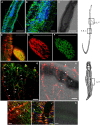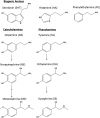Octopamine signaling in the metazoan pathogen Schistosoma mansoni: localization, small-molecule screening and opportunities for drug development
- PMID: 29925529
- PMCID: PMC6078403
- DOI: 10.1242/dmm.033563
Octopamine signaling in the metazoan pathogen Schistosoma mansoni: localization, small-molecule screening and opportunities for drug development
Abstract
Schistosomiasis is a tropical disease caused by a flatworm trematode parasite that infects over 200 million people worldwide. Treatment and control of the disease rely on just one drug, praziquantel. The possibility of drug resistance coupled with praziquantel's variable efficacy encourages the identification of new drugs and drug targets. Disruption of neuromuscular homeostasis in parasitic worms is a validated strategy for drug development. In schistosomes, however, much remains to be understood about the organization of the nervous system, its component neurotransmitters and potential for drug discovery. Using synapsin as a neuronal marker, we map the central and peripheral nervous systems in the Schistosoma mansoni adult and schistosomulum (post-infective larva). We discover the widespread presence of octopamine (OA), a tyrosine-derived and invertebrate-specific neurotransmitter involved in neuromuscular coordination. OA labeling facilitated the discovery of two pairs of ganglia in the brain of the adult schistosome, rather than the one pair thus far reported for this and other trematodes. In quantitative phenotypic assays, OA and the structurally related tyrosine-derived phenolamine and catecholamine neurotransmitters differentially modulated schistosomulum motility and length. Similarly, from a screen of 28 drug agonists and antagonists of tyrosine-derivative signaling, certain drugs that act on OA and dopamine receptors induced robust and sometimes complex concentration-dependent effects on schistosome motility and length; in some cases, these effects occurred at concentrations achievable in vivo The present data advance our knowledge of the organization of the nervous system in this globally important pathogen and identify a number of drugs that interfere with tyrosine-derivative signaling, one or more of which might provide the basis for a new chemotherapeutic approach to treat schistosomiasis.This article has an associated First Person interview with the first author of the paper.
Keywords: Biogenic amine; Dopamine; Drug discovery; Nervous system; Neuromuscular; Octopamine; Schistosoma mansoni; Synapsin.
© 2018. Published by The Company of Biologists Ltd.
Conflict of interest statement
Competing interestsThe authors declare no competing or financial interests.
Figures







Similar articles
-
Identification of annotated bioactive molecules that impair motility of the blood fluke Schistosoma mansoni.Int J Parasitol Drugs Drug Resist. 2020 Aug;13:73-88. doi: 10.1016/j.ijpddr.2020.05.002. Epub 2020 Jun 1. Int J Parasitol Drugs Drug Resist. 2020. PMID: 32531750 Free PMC article.
-
Neurotransmitter transporters in schistosomes: structure, function and prospects for drug discovery.Parasitol Int. 2013 Dec;62(6):629-38. doi: 10.1016/j.parint.2013.06.003. Epub 2013 Jun 22. Parasitol Int. 2013. PMID: 23800409 Review.
-
A novel G protein-coupled receptor of Schistosoma mansoni (SmGPR-3) is activated by dopamine and is widely expressed in the nervous system.PLoS Negl Trop Dis. 2012;6(2):e1523. doi: 10.1371/journal.pntd.0001523. Epub 2012 Feb 28. PLoS Negl Trop Dis. 2012. PMID: 22389736 Free PMC article.
-
Discovery and Characterization of Novel Anti-schistosomal Properties of the Anti-anginal Drug, Perhexiline and Its Impact on Schistosoma mansoni Male and Female Reproductive Systems.PLoS Negl Trop Dis. 2016 Aug 12;10(8):e0004928. doi: 10.1371/journal.pntd.0004928. eCollection 2016 Aug. PLoS Negl Trop Dis. 2016. PMID: 27518281 Free PMC article.
-
Tissue-specific transcriptome analyses provide new insights into GPCR signalling in adult Schistosoma mansoni.PLoS Pathog. 2018 Jan 18;14(1):e1006718. doi: 10.1371/journal.ppat.1006718. eCollection 2018 Jan. PLoS Pathog. 2018. PMID: 29346437 Free PMC article. Review.
Cited by
-
Quantifying the mechanics of locomotion of the schistosome pathogen with respect to changes in its physical environment.J R Soc Interface. 2019 Jan 31;16(150):20180675. doi: 10.1098/rsif.2018.0675. J R Soc Interface. 2019. PMID: 30958153 Free PMC article.
-
Form and Function in the Digenea, with an Emphasis on Host-Parasite and Parasite-Bacteria Interactions.Adv Exp Med Biol. 2024;1454:3-45. doi: 10.1007/978-3-031-60121-7_1. Adv Exp Med Biol. 2024. PMID: 39008262 Review.
-
Identification of annotated bioactive molecules that impair motility of the blood fluke Schistosoma mansoni.Int J Parasitol Drugs Drug Resist. 2020 Aug;13:73-88. doi: 10.1016/j.ijpddr.2020.05.002. Epub 2020 Jun 1. Int J Parasitol Drugs Drug Resist. 2020. PMID: 32531750 Free PMC article.
-
Schistosomiasis Drug Discovery in the Era of Automation and Artificial Intelligence.Front Immunol. 2021 May 31;12:642383. doi: 10.3389/fimmu.2021.642383. eCollection 2021. Front Immunol. 2021. PMID: 34135888 Free PMC article. Review.
-
Comparative transcriptome profiles of Schistosoma japonicum larval stages: Implications for parasite biology and host invasion.PLoS Negl Trop Dis. 2022 Jan 13;16(1):e0009889. doi: 10.1371/journal.pntd.0009889. eCollection 2022 Jan. PLoS Negl Trop Dis. 2022. PMID: 35025881 Free PMC article.
References
-
- Abdulla M.-H., Ruelas D. S., Wolff B., Snedecor J., Lim K.-C., Xu F., Renslo A. R., Williams J., McKerrow J. H. and Caffrey C. R. (2009). Drug discovery for schistosomiasis: hit and lead compounds identified in a library of known drugs by medium-throughput phenotypic screening. PLoS Negl. Trop. Dis. 3, e478 10.1371/journal.pntd.0000478 - DOI - PMC - PubMed
Publication types
MeSH terms
Substances
Grants and funding
LinkOut - more resources
Full Text Sources
Other Literature Sources

